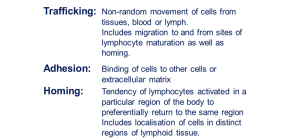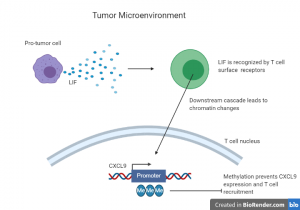45 Unit 3.1: Homing of T cells in the Tumor Microenvironment
One of the most important parts of the T cell anti-cancer response is the localization of T cells to the tumor. T cells require close proximity to antigen, other signalling cells, and tumor cells themselves to have effective action. Therefore, understanding the complex ligands and small molecules such as chemokines that control the localization and homing of T cells is crucial to optimizing the anti-cancer response.
Ligands on T cells changes depending on their maturation and activation state. These changes guide physical localization.

Figure 1: Ligands involve in the life and fate of T cell localization. Obtained from: Janeway’s Immunology, 9th edition.
Lymphocytes are originally trafficked from the bone marrow where they development from the hematopoietic stem cell, which is the progenitor for all blood cells. T cells are then further developed to the naïve state in the thymus. After selection, T cells migrate to the periphery from the thymus and encounter antigens in the lymph node after cross from the vasculature into the lymphatic system.
progenitor for all blood cells. T cells are then further developed to the naïve state in the thymus. After selection, T cells migrate to the periphery from the thymus and encounter antigens in the lymph node after cross from the vasculature into the lymphatic system.
Understanding the complex movement of T cells is important, this video describes the egress and extravasation of T cells:
https://www.youtube.com/watch?v=wTN7AP1WTUI
It is important to remember that cancer is driven by driver mutations which promote immunological escape (as you learned earlier in unit 2). Physical escape from antigen presenting cells and T cells is a part of this strategy. Tumors have several mechanisms of physically escaping T cells. For example:
- Dense solid tumors avoid T cell exposure within the middle of their structure
- Cancer cells can create barriers out of connective tissue to escape recognition
- Manipulation of chemokines and chemical signals can prevent T cells egress
Pathological conditions can manipulate the environment in favour of certain conditions. For example, LIF is a chemokine which is important in the early development of embryos and polarization of cells. LIF has a further role in T cell homeostasis. It is well known that CD8 T cells need to infiltrate tumor microenvironments to release granzymes and perforin close to cancerous cells after interacting with them.
One of the most important chemokine gradients causing T cells to home to pathology is CXCL9. CXCL9 attracts T cells and its expression can be regulated at the DNA level by LIF. A series of intracellular cascades following LIF binding to the surface of regulatory cells methylates the promoter region of CXCL9. Upon methylation, the CXCL9 gene is silenced and cannot be transcribed.

Figure 2: The relationship between LIF and CXCL9 influence T cell localization. Created in BioRender by Shannon Snelling.
CXCL9 silencing by LIF therefore reduces T cell migration to the area. Cancer cells can use strategies such as this one to evade the immune system.
Thinking question…….
Remember what you learned from Unit 2. What technique could be applied to mitigate the effect of LIF on T cells?
Test your knowledge
